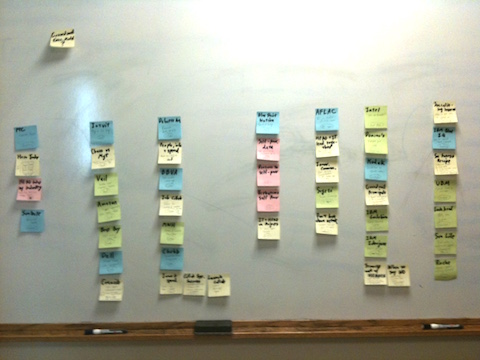How to rewrite a book in one day (with sticky notes)
In 2009, Ted Schadler and I had a problem. The back half of our book Empowered wasn’t working. This is how we fixed it.
We were nearing the manuscript deadline for Empowered, Ted’s and my book about strategies to deal with empowered consumers and workers. The front half of the book, about consumers (and marketing), was holding together pretty well. But the back half, about workers and corporate technology, wasn’t. We’d done the interviews and written up the case studies. We’d come up with the concepts and frameworks. We had whole chapters written.
But structurally, we knew it was problematic. Parts were redundant. In other places, it wasn’t clear what order things went in. One chapter was way too heavy in data. So Ted and I reserved a small conference room and resolved to fix it.
Before our meeting, I’d deconstructed the whole second half of the book into sticky notes: blue for full case studies, green for shorter one- or two-paragraph examples, yellow for concepts, and pink for data frameworks. Here’s how it looked:
Ted and I tossed around ideas for restructuring things. We figured out that three of the chapters were particularly entangled with each other, and rethought the organization of those chapters. We rethought the order of the chapters, too. Then we started moving stickies around.
In about an hour, we’d come up with a solution we liked. A few examples and concepts ended up on the floor, but that was fine — the book was already too long.I re-collated the sticky notes and stapled them together into little sheafs. The plan for the rewrite touched 130 pages, seven chapters, and 30,000 words of the book. Implementing it was my job.
The next day, I got to work on the rewrite. I cut and pasted the pieces into the new order. Then I rewrote about 3,000 words of transitions, connections, and backward and forward references throughout the new chapters. In some cases, I changed the emphasis or “moral” of a case study, or deleted elements that we no longer needed. I wrote a couple of short sections that our new arrangement demanded. I resisted the urge to tinker with the rest of the text.
I finished it in one day. It was remarkably easy and stress free. Here’s why:
- We had been disciplined in how we structured things — the pieces were as modular as possible. Ted and I had agreed beforehand on what made up a chapter, and we’d both written in a way that preserved those principles.
- The pieces were in great shape. The book wasn’t a mess, only the structure was.
- We hadn’t been repetitive. For the most part, stuff about a case study stayed with that case study. We explained a concept in one place, not all over the place. (Most business books fail on this account).
- Our transitions were disciplined, a couple of sentences to connect each concept or example to the next.
[tweetthis twitter_handles=”@jbernoff”]Write in discrete, modular pieces. It’ll save you a lot of tears in the rewrite.[/tweetthis]
It’s a terrifying thing when a book isn’t working. But if you’ve been careful and disciplined in creating the content, you can solve the problem — especially with two minds at work. Just make sure you’ve got a whiteboard and an adequate supply of color-coded sticky notes.

This is valuable advice. One question for you, Josh: do you think it would have been as easy to rethink things if you didn’t have a writing partner on that project? In other words, how difficult is it for a sole author to emotionally detach from a project enough to make deep changes such as you did?
Scott, it is virtually impossible for a single person to get the perspective needed to do a rewrite of this kind. If you don’t have a coauthor, then you’d need to have an editor: someone else who’s invested in the project, but is not you.
This reminds me of mind mapping techniques suggested by Pat at smartpassiveincome.com for structuring ideas for eBooks quickly. However your methodology is much more tactile and charming, as it resembles storyboarding or even screenplay writing.